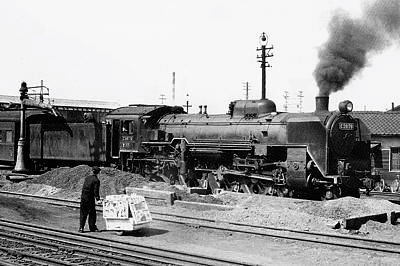
C59 No.179
just leaveing Kurashiki station, Sanyo line
March 1959.
(Photo credit to S.Sumino)
Japanese
|
1941 - 1970 A large Tender-Engine for arterial railroad express passenger trains. |

C59 No.179 just leaveing Kurashiki station, Sanyo line March 1959. (Photo credit to S.Sumino) |
|
Japan's first modern standard freight engine D51 appeared during 1936.
After that, the sub-main line passenger engine C57 appeared during 1937,
and for local line operations the modern standard model C58 appeared during 1938. But, a large passenger model for express and limited expresses for arterious lines was not required because the C53 was good enough. However, after 1940, there was an increased need for a modern standard passenger model on arterious lines as an alternative for the complicated three-cylinder model C53. C59 exceeded all of the C53's performance, but its weight was lighter than the C53. And C59 had a long body and big tender for long runs as her central feature. Her 19.1 meter length was the outer limit length for Japan's 20 meter long turn-tables. Soon after the inception of the C59, it appeared on Tokaido and Sanyo main lines with favorable on-site reaction as compared with the C53. The first C59 was manufactured at the Kisha Seizo Co. it's manufactured number was just 2000 during May 1941, and it was active on the Tokaido, Sanyo lines. During November 1956, she was transferred to the Kyushu Moji depot, and was later moved to the Kumamoto depot and was retired during October 1965. C59_1 was preserved at the JNR Kokura works as a railway monument, and during August 2003, she was exhibited at the Kyushu Railway History Museum. A total of 100 (No.1 - 100) were made up to 1943. The distribution of the engine was rather uniform : Nagoya 17, Maibara 8, Umekoji 11, Itozaki 13, Hiroshima 16 and Shimonoseki 14. After WW2, 73 more engines were added (No.101-132, 156-196) for a total of 173 engines, and these 73 engines were a bit changed in design. C59 No.133-155 were already number assigned, but later aborted due to tight financing policy on the way. These numbers were unused numbers. After WW2, 170 C59s were active on the Tokaido and Sanyo lines, with the exception of three, which were war-damaged (No.6, 63 and 93). The area of activity of the C59 was lessened after the appearance of the C62 and electrification. Because of the heavier axle load of the C59, line conversion was not great. Therefore, 47 engines were altered with a relieved axle load (4-6-2 -> 4-6-4) during the years of 1953, 1954 and 1960. The class names were changed to C60. After the electrification of the Tokaido and Sanyo lines, several C59's were transferred to the Tohoku (Southward from Sendai) and Kagoshima line (Northward from Kumamoto). But C59's culling began during an earlier period in 1958. C59s were decreased to about 99 during 1960. 10 years later, during 1964, the number was decreased to 26. They were ; 2 in the Sendai depot (No.90 and 176) for the Tohoku line between Sendai and Ichinoseki .... Sendai - Morioka section electrified Oct 1965. 7 in the Itozaki depot (No.131, 161, 162, 164, 175, 190 and 196) for the Sanyo and Kure line, 6 in the Hiroshima depot (No.104, 116, 123, 179, 180 and 183) for the Sanyo line, .... Sanyo line electrified Jul 1964. 10 in the Kumamoto depot (No.1, 30, 31, 74, 95, 105, 119, 121, 124 and 129) for the Kagoshima line, Kumamoto section electrified Sep 1965. The larger C59 almost disappeared from the railroad scene. There were three last C59's (C59 161, 162 and 164) on the Kure line, Itozaki depot. And the withdrawal of the last C59 from Kure line electrification, took place during October 1970. |
| Primary ran line in last 10 years |
Kure
| Last line/depot and year |
Kure line / Itozaki depot Sept.1970
| Restored engine (2017) |
none
| Preserved engine (2017) |
3 (No.1, 161, 164)
| |
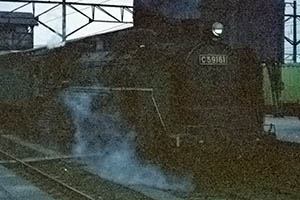
|
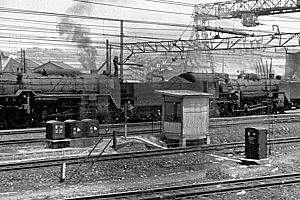
| ||||
|
C59 161 Itozaki station, Aug 1968 |
Left C62 and right C59_161 at Hiroshima depot, Mar 1968
| 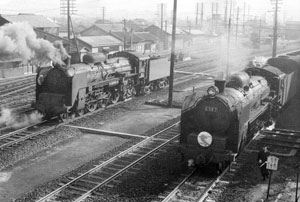
| 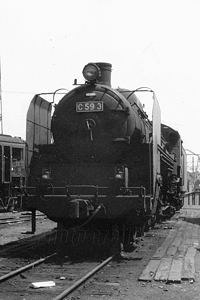
Express "Hayabusa (Falcon)" pulled by C61 33 (left) | and engines changed to C59 7 (Right) in Hakata. Apr.1959 (Photo credit to S.Sumino)
C59_3 at Oku depot in Tokyo 1963.
| (Photo in T.S. possession) |
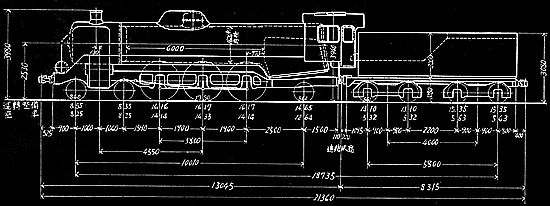
| Configuration | 4-6-2 | Dimensions Length (mm) | 21360 (21575) |
| Engine Weight (Operating tons) | 80.3 (79.8) | Driver size (mm diameter) | 1750 |
| Boiler pressure (Kg/cm2) | 16.0 | Max Tractive effort (tons) | 12.1 (12.2) |
| Driver Max Power (PS) | 1750 | Max Speed (km/h) | 100 |
| Manufactured years | 1941-1943 1946,47 | Total production | 173 |
| Remodeling | 47 -> Class 4-6-4 C60 1953,54,60 | Gauge | 3ft 6in (1067mm) |
* Parenthetic ; After No.101 |
Introduction |
Go to Top |